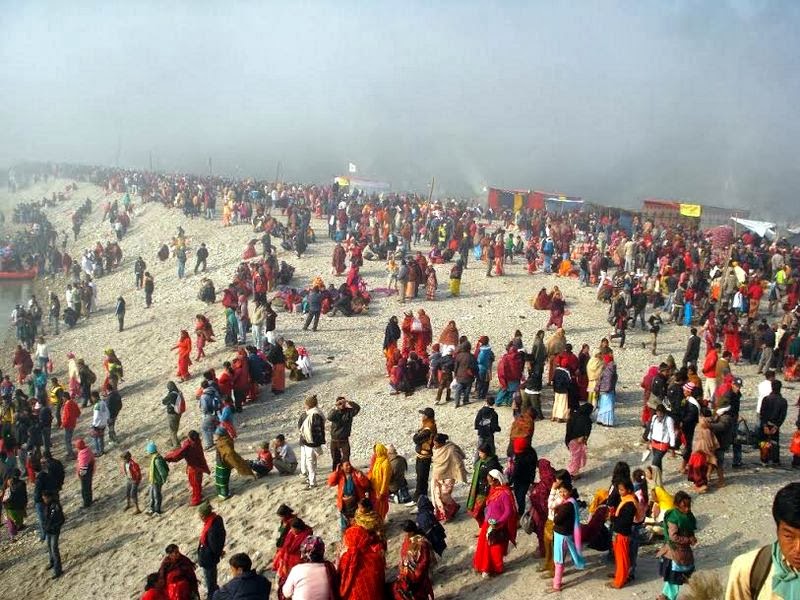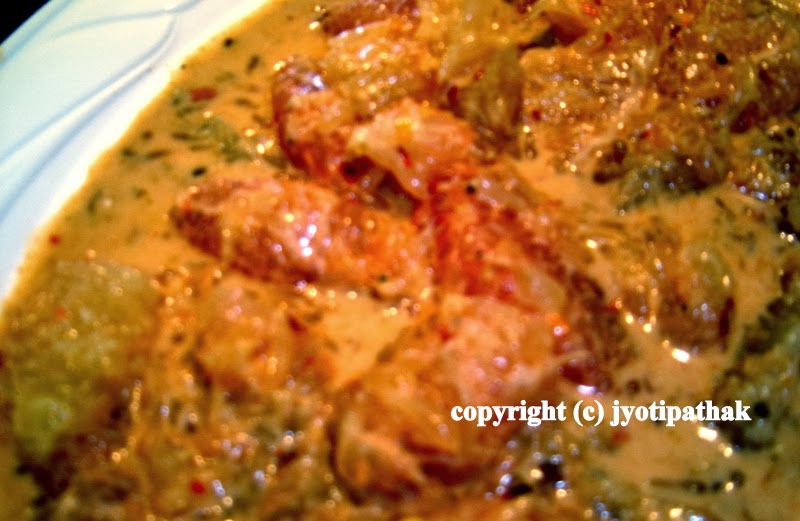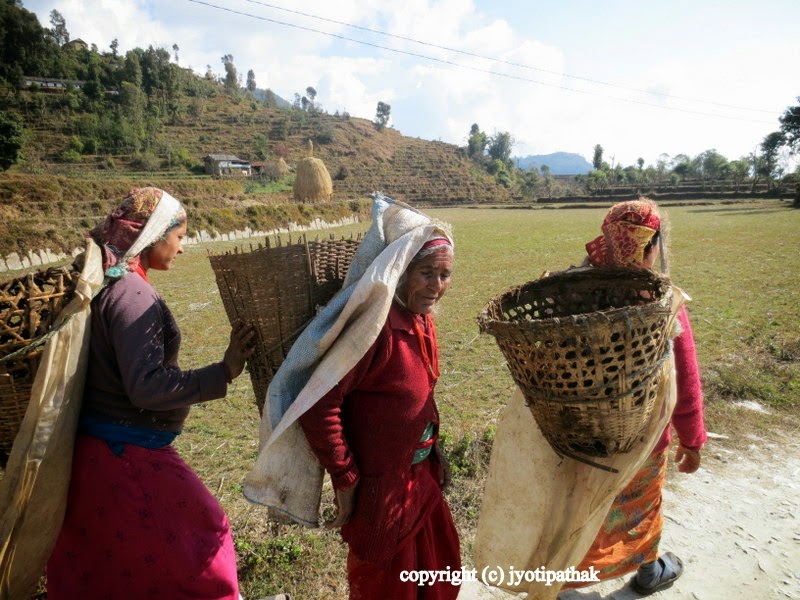Nepali Goat Curry - बोका को मासु
![]() |
| Serving Goat Curry during festive occasion |
In Nepal, Vijaya Dashami (विजया दशमी), Dashain (दशैं) or Bada-Dashain (बडा दशैं), the most important religious festival of Nepal is almost approaching (October 6, 2013). It is time to post about the most loved festival and the feast. During this festival, a large number of male goats, sheep, water-buffalo, pigs, ducks and chicken are sacrificed before the goddess in the temple, or other places like Kot Square, or some private homes and offered to the deities. After religious rites are performed, the ritually sacrificed animals are cooked and distributed among friends, relatives, and neighbors. For many families, this may be one of the few occasions during the year that they are able to eat meat. The most common and preferred meat is a freshly slaughtered goat and the Nepali word for goat is the same as the generic word for meat (bokaa and khasi). Meat from castrated goats are called khasi ko maasu (खसीकोमासु). All animal parts are eaten, including the liver, intestines, brain, kidney, tongue, tripe, and blood. At Dashain time, great feasts are prepared in many homes and a large quantity of prasaad ko maasu (blessed meat) is consumed. In Nepal, butchered animals are cooked and eaten right after slaughtering, rather than stored. The meat is prepared well done. Most frequently, it is cooked in a pressure cooker to speed the cooking process.
Meat is a high-status food and does not feature frequently in the regular diet of most Nepalese people. Poorer people consume meat only on special occasions and festivities, while the urban middle class consume meat more frequently. Other common meats eaten in Nepal include lamb (bheda) or pork (bangoor or banel). The majority of Nepalese do not eat beef for religious reasons, being Hindu. In many areas of Nepal, certain ethnic groups eat water buffalo (raango ko maasu) as their primary source of meat. Water buffalo is extremely lean and tender. It is also versatile and lends itself to spicy cooking. Water buffalo was once a less expensive alternative to to goat, but as a greater portion of population is beginning to recognize its health benefits, it is becoming increasingly expensive. Game, such as boar (banel) and venison (mirga), is popular in some regions and usually signifies a family celebration. Venison is usually obtained by hunting. Due to lack of refrigeration, on hunting trips it is sun-dried so that it doesn't spoil. In the high altitude areas of Nepal near Tibetan boarder, yak meat (chamari gai) is consumed fresh or dried.
In Nepali, “teen-taha-ko maasu" is translated as three layers of meat, and corresponds to how the meat is cut. These layers consists of meat, skin, thick fat rind, and bone. The special cut pieces of goat is meat is most preferred cut. It is believed that the meat, which is attached to the bone, is the most tender and flavorful. The second layer, the skin is considered a delicacy and is a part of the dish. Fat, the final layer, which is usually left in the meat pieces to cook, because it bastes the meat and makes it tender as it cooks. Nepalese cook are very careful to balance the texture, flavor and the color of the meat and the finished dish is very flavorful goat with some gravy.
Dashain is just around the corner, and a lot of goat has been transported to Kathmandu for this religious season. Come and explore the goat curry and let me show you how I prepare my goat. The recipe is perhaps the most popular way of cooking goat meat during Dashain and other festive occasion. I have provided the full recipe at the end of this post.
![]() |
| Serving Nepali Daal-Bhaat-Tarkaari - Nepalese find goat meat very tasty and usually it is a treat to serve tender goat curry for a special occasion. |
![]() |
When researching for goat meat for this post, I found this information about the goat meat - "Goat meat is often called chevon or mutton when the meat comes from adults, and cabrito, capretto, or kid when from young animals. While `goat' is usually the name for the meat found in common parlance, producers and marketers may prefer to use the French-derived word chevon (from chèvre), since market research in the United States suggests that "chevon" is more palatable to consumers than "goat meat". Cabrito, a word of Spanish origin, refers specifically to young, milk-fed goat. In the English-speaking islands of the Caribbean, and in some parts of Asia, particularly Bangladesh, Nepal, Sri Lanka, Pakistan and India, the word “mutton” is often used colloquially to describe both goat and sheep meat, despite technically only referring to sheep meat"....... to read the entire article, please click here. |
![]() |
Goat meat is widely available in Nepal, but it is not usually for sale in my local grocery store in the area where I live. We buy the farm-raised goat from a local farm, then transport to the meat processing butcher. It will be cut into our specifications piece according to our order, mostly into bone-in 1 ½-inch pieces, which is best for curry. Many families split 1/2 or whole goat and share the cost. Goat meat is readily available in big cities, where a large number of immigrants from India, Pakistan, Caribbean, South Asian, and the Middle East live. |
![]() |
This recipe calls for bone-in young and tender goat (please check the ingredients at the end of this post).
Rinse the goat well under cold water, drain and place it in a medium-size bowl. Set aside while you prepare the spice. Heat a small cast-iron skilled over medium-low heat and toast the cinnamon, coriander, cumin, green cardamom, peppercorns, fennel, bay leaves, black cardamom pods, and cloves, stirring constantly until they give off a pleasant aroma and heated through 2 to 3 minutes. Pour into a dry container to halt the toasting. Cool and remove the seeds from the cardamom and discard the pods. Place the spices in a spice grinder or a mortar and pestle and grind to a fine powder. Drain the chilies and coarsely grind them into a paste with mortar and pestle or spice grinder. In a small bow, combine the oil, garlic, ginger, salt, nutmeg, chili paste, and toasted spices. Rob the spice mixture over the meat. Cover and allow the meat to marinate for 30 minutes at room temperature or refrigerate it overnight, but bring it back to room temperature before cooking. |
|
![]() |
| Place the marinated meat in a large heavy-bottomed saucepan. Cook, uncovered, over medium-high heat, stirring from time to time, until the meat loses its pink color and comes to a boil, 7 to 8 minutes. |
![]() |
| Lower the heat, cover, and simmer, stirring often to prevent to scorching, until the meat is tender and cooked through, and the juices are absorbed into the meat. The cooking time depends on the quality and age of the goat. If the meat has not reached the desired tenderness, add 1/2 cup hot water and continue cooking until it is tender and most of the juices have evaporated. |
![]() |
| Transferring the meat to a serving dish and serving hot. |
![]() |
| Goat curry tastes even better as a leftover. |
![]() |
| Enjoy the sample of Dashain feast here (picture top and bottom) cooked during the festival time - from Jyoti's kitchen |
![]() |
| A rusty and authentic soupy goat curry served with a selection of fresh vegetables, assortment of pickles and a freshly steamed rice. |
![]() |
| Getting ready to cook a large amount of goat meat for a family feast. In Nepal, meat from the castrated goats is called "khasi ko maasu" and the young tender goat meat is called "bokaa ko maasu". |
![]() |
| Classic Dashain goat curry - (दशैं को मासु) - our Nepali feast was cooked with a generous amount of ginger-garlic (pounded in a stone mortar-pestle), shallots, and several other spices along with mustard oil to make this delicious flavored spicy feast. We ate the goat curry with a very Nepali way -- with a generous serving of freshly steamed rice. |
![]() |
| A delicious and authentic variation of goat curry -"tin-taha ko khasi ko maasu" - translated into "three layers of meat" and corresponds to how the meat is cut. The layers consists of bone-in and boneless meat pieces with the thick fat and skin attached. The meat that is attached to the bone is most tender and flavorful. The skin is considered delicacy, and the fat layer is left in because it help to baste the meat and makes it tender as it cooks. |
|
![]() |
| Another variation of goat curry - yogurt marinated tender young goat with the addition of onions, tomato, ginger, garlic and several other fresh herbs and spices added to make this delicious curry. |
![]() |
| All the flavors and fragrance of Nepali cooking -- meet my favorite lady, who runs a neighboring restaurant in the Makhan Tole area in the heart of Kathmandu near my parent's house. She is letting me take a picture of her signature goat curry dish in the front. "There is nothing like savoring her exotic goat curry prepared by her everyday," says a smiling customer who was watching me take a picture. |
![]() |
| Goat meat for sale at the open air meat market in Nepal. If you notice the yellow color in the meat that is because the freshly slaughtered goat skin is rubbed with turmeric powder to help preserve the meat. It also have antiseptic properties. |
![]() |
| Here is an another image of slaughtered animal that is rubbed with turmeric powder to help preserve the meat. |
![]() |
| Slow cooked curried goat spiced to perfection | | | | | | | | |
|
|
|
|
|
Here are some useful and informative links about goat, please read about it here.
"How I learned to cook goat meat," from New York Times, please click
here.
For Dashain -Goats, sheep to be brought to Kathmandu market from Kathmandu Post, please click
here.
My recipe, "Nepali Goat Curry," was submitted to Asian recipe website about six years ago, please click here to see the complete
recipe here, and click
here for main page.
I am so glad that I was able to share my recipe of goat curry - now it is showing in these web pages - please check
here -
here -
here.Goat Meat from Wiki - please click
here.
Goat Cheese farm in Nepal, please click
here and
here.
Goat Curry Recipe
Ingredients
2 1/2 to 3 pounds bone-in young goat (preferably from the leg), trimmed and cut into 1 1/2-inch pieces
1 (1-inch) stick cinnamon
2 teaspoons coriander seeds
1 1/2 teaspoons cumin seeds
4 to 6 green cardamom pods, crushed
1/4 teaspoon black peppercorns
1/8 teaspoon fennel seeds
2 to 3 bay leaves
1 black cardamom pod, crushed
4 whole cloves
2 to 3 dried red chillies, halved, seeded, and soaked in 1/4 cup hot water until soft
1/4 cup vegetable oil
4 to 6 medium cloves garlic, minced
1 1/2 tablespoons minced fresh ginger
1 teaspoon ground turmeric
Salt to taste
1/8 teaspoon ground nutmeg
1/2 cup finely chopped cilantro







+291.jpg)



+056.jpg)
+015.jpg)





+650.jpg)
+493.jpg)











